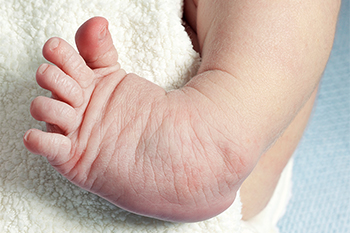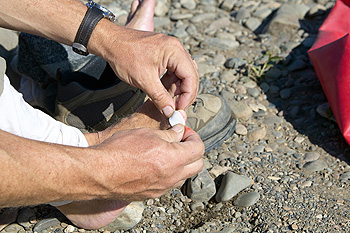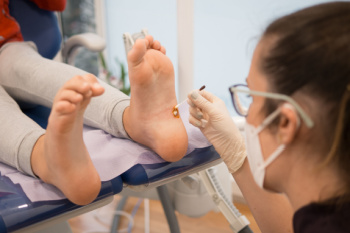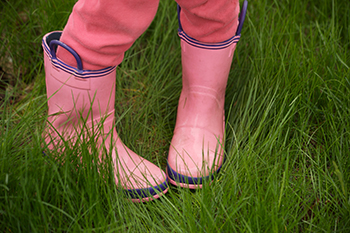Connect With Us
Blog
Items filtered by date: November 2024
Definition and Causes of Idiopathic Congenital Clubfoot:

Idiopathic congenital clubfoot is a birth defect in which a baby is born with one or both feet twisted inward and downward. The term idiopathic means that the exact cause of the condition is unknown, although it is believed to result from a combination of genetic and environmental factors. The affected foot or feet may appear deformed, with the heel pointing downward and the toes turning inward, making it difficult for the child to stand or walk normally. Clubfoot can occur in isolation or as part of a broader condition, but in most cases, it does not affect other parts of the body. Early treatment is essential and usually involves methods, such as the Ponseti technique, which includes gentle manipulation and casting of the foot to gradually correct the deformity. In some cases, surgery may be required if other treatments do not work. If your child has been born with clubfoot, it is strongly suggested that a podiatrist is included on the healthcare team who can effectively monitor this condition.
Congenital foot problems require immediate attention to avoid future complications. If you have any concerns, contact one of our podiatrists of Brondon Foot and Ankle. Our doctors can provide the care you need to keep you pain-free and on your feet.
Congenital foot problems are deformities affecting the feet, toes, and/or ankles that children are born with. Some of these conditions have a genetic cause while others just happen. Some specific foot ailments that children may be born with include clubfeet, polydactyly/macrodactyly, and cleft foot. There are several other foot anomalies that can occur congenitally. What all of these conditions have in common is that a child may experience difficulty walking or performing everyday activities, as well as trouble finding footwear that fits their foot deformity. Some of these conditions are more serious than others. Consulting with a podiatrist as early as possible will help in properly diagnosing a child’s foot condition while getting the necessary treatment underway.
What are Causes of Congenital Foot Problem?
A congenital foot problem is one that happens to a child at birth. These conditions can be caused by a genetic predisposition, developmental or positional abnormalities during gestation, or with no known cause.
What are Symptoms of Congenital Foot Problems?
Symptoms vary by the congenital condition. Symptoms may consist of the following:
- Clubfoot, where tendons are shortened, bones are shaped differently, and the Achilles tendon is tight, causing the foot to point in and down. It is also possible for the soles of the feet to face each other.
- Polydactyly, which usually consists of a nubbin or small lump of tissue without a bone, a toe that is partially formed but has no joints, or an extra toe.
- Vertical talus, where the talus bone forms in the wrong position causing other bones in the foot to line up improperly, the front of the foot to point up, and the bottom of the foot to stiffen, with no arch, and to curve out.
- Tarsal coalition, when there is an abnormal connection of two or more bones in the foot leading to severe, rigid flatfoot.
- Cleft foot, where there are missing toes, a V-shaped cleft, and other anatomical differences.
- Macrodactyly, when the toes are abnormally large due to overgrowth of the underlying bone or soft tissue.
Treatment and Prevention
While there is nothing one can do to prevent congenital foot problems, raising awareness and receiving neonatal screenings are important. Early detection by taking your child to a podiatrist leads to the best outcome possible.
If you have any questions please feel free to contact our office located in Centerville, OH . We offer the newest diagnostic tools and technology to treat your foot and ankle needs.
Causes and Relief From Foot Blisters While Hiking

Foot blisters are a common nuisance for hikers, often caused by friction, moisture, and wearing poorly fitting footwear. When the skin rubs against shoes or socks, the top layer of skin can separate, leading to fluid-filled blisters. To prevent these painful injuries, selecting the right footwear is vital, as shoes should fit well and provide ample support. Choosing moisture-wicking socks can help keep feet dry, reducing friction and the likelihood of blisters. Additionally, applying blister prevention products, such as adhesive pads, can offer an extra layer of protection. It is also beneficial to gradually break in new shoes before embarking on long hikes to allow the feet to adjust. Foot blisters can easily deter hikers from partaking in long or short hikes. If you have developed a blister from hiking, it is suggested that you confer with a podiatrist who can offer you effective relief and prevention solutions.
Blisters are prone to making everyday activities extremely uncomfortable. If your feet are hurting, contact one of our podiatrists of Brondon Foot and Ankle. Our doctors can provide the care you need to keep you pain-free and on your feet.
Foot Blisters
Foot blisters develop as a result of constantly wearing tight or ill-fitting footwear. This happens due to the constant rubbing from the shoe, which can often lead to pain.
What Are Foot Blisters?
A foot blister is a small fluid-filled pocket that forms on the upper-most layer of the skin. Blisters are filled with clear fluid and can lead to blood drainage or pus if the area becomes infected.
How Do Blisters Form?
Blisters on the feet are often the result of constant friction of skin and material, usually by shoe rubbing. Walking in sandals, boots, or shoes that don’t fit properly for long periods of time can result in a blister. Having consistent foot moisture and humidity can easily lead to blister formation.
Prevention & Treatment
It is important to properly care for the affected area in order to prevent infection and ease the pain. Do not lance the blister and use a Band-Aid to provide pain relief. Also, be sure to keep your feet dry and wear proper fitting shoes. If you see blood or pus in a blister, seek assistance from a podiatrist.
If you have any questions, please feel free to contact our office located in Centerville, OH . We offer the newest diagnostic and treatment technologies for all your foot care needs.
Understanding Plantar Warts

Plantar warts are small, rough growths that occur on the soles of the feet, caused by the human papillomavirus. These warts can be uncomfortable and often appear as hardened, raised areas with small black dots, which are actually tiny blood vessels. Symptoms typically include pain or tenderness when walking or standing, making daily activities challenging. Diagnosis usually involves a physical examination by a podiatrist, who may confirm the presence of a wart based on its appearance and location. In some cases, a biopsy may be performed to rule out other conditions. Preventing plantar warts involves maintaining foot hygiene, wearing appropriate footwear in communal areas, and avoiding direct contact with warts on other individuals. If you have developed this potentially painful condition, it is suggested that you consult a podiatrist who can offer you appropriate treatment solutions.
Plantar warts can be very uncomfortable. If you need your feet checked, contact one of our podiatrists from Brondon Foot and Ankle. Our doctors will assist you with all of your foot and ankle needs.
About Plantar Warts
Plantar warts are the result of HPV, or human papillomavirus, getting into open wounds on the feet. They are mostly found on the heels or balls of the feet.
While plantar warts are generally harmless, those experiencing excessive pain or those suffering from diabetes or a compromised immune system require immediate medical care. Plantar warts are easily diagnosed, usually through scraping off a bit of rough skin or by getting a biopsy.
Symptoms
- Lesions on the bottom of your feet, usually rough and grainy
- Hard or thick callused spots
- Wart seeds, which are small clotted blood vessels that look like little black spots
- Pain, discomfort, or tenderness of your feet when walking or standing
Treatment
- Freezing
- Electric tool removal
- Laser Treatment
- Topical Creams (prescription only)
- Over-the-counter medications
To help prevent developing plantar warts, avoid walking barefoot over abrasive surfaces that can cause cuts or wounds for HPV to get into. Avoiding direct contact with other warts, as well as not picking or rubbing existing warts, can help prevent the further spread of plantar warts. However, if you think you have developed plantar warts, speak to your podiatrist. He or she can diagnose the warts on your feet and recommend the appropriate treatment options.
If you have any questions please feel free to contact our office located in Centerville, OH . We offer the newest diagnostic and treatment technologies for all your foot and ankle needs.
Treatment for Children’s Intoeing

Intoeing, commonly known as pigeon toes, is a condition where a child's feet turn inward instead of pointing straight ahead. This condition often appears in infants and young children and can involve one or both feet. In many cases, intoeing is due to natural variations in bone alignment and often improves as the child grows. For infants, the inward curve may be caused by a condition called metatarsus adductus, where the front part of the foot turns inward. As children get older, intoeing may be related to the twisting of the tibia, or shinbone, or the femur, or thighbone. While intoeing in children often resolves on its own without treatment, a podiatrist can evaluate the condition to determine if stretches, braces, or in rare cases, surgery may be required. Early consultation helps to ensure that your child's gait develops normally and prevents future complications. If your child is intoeing, it is suggested that you schedule an appointment with a podiatrist for an evaluation and treatment options.
The health of a child’s feet is vital to their overall well-being. If you have any questions regarding foot health, contact one of our podiatrists of Brondon Foot and Ankle. Our doctors can provide the care you need to keep you pain-free and on your feet.
Tips for Keeping Children's Feet Healthy
- Make sure their shoes fit properly
- Look for any signs of in-toeing or out-toeing
- Check to see if they have Clubfoot (condition that affects your child’s foot and ankle, twisting the heel and toes inward) which is one of the most common nonmajor birth defects.
- Lightly cover your baby’s feet (Tight covers may keep your baby from moving their feet freely, and could prevent normal development)
- Allow your toddler to go shoeless (Shoes can be restricting for a young child’s foot)
- Cut toenails straight across to avoid ingrown toenails
- Keep your child’s foot clean and dry
- Cover cuts and scrapes. Wash any scratches with soap and water and cover them with a bandage until they’ve healed.
If you have any questions, please feel free to contact our office located in Centerville, OH . We offer the newest diagnostic and treatment technologies for all your foot care needs.

